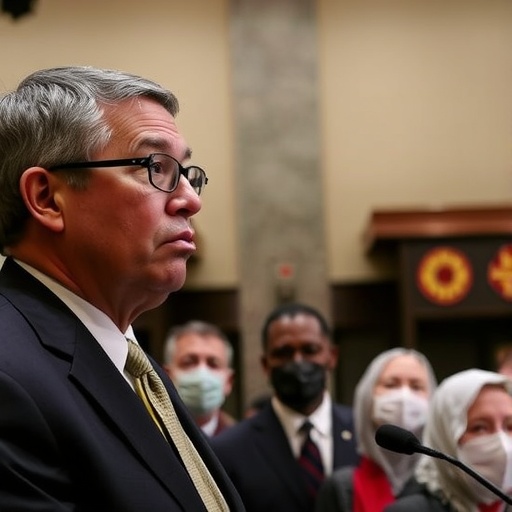US Government shutdown Reaches Day 26: Treasury Secretary Blames Schumer and Jeffries as Federal Employees Scramble for Food Aid
In a stark illustration of the human cost of political gridlock, federal employees across the United States are lining up at food banks for the first time in their careers as the Government shutdown stretches into its 26th day. Treasury Secretary Scott Bessent issued a scathing rebuke of Democratic leadership, accusing Senate Majority Leader Chuck Schumer and House Minority Leader Hakeem Jeffries of obstructing simple measures to keep the government funded, potentially jeopardizing military paychecks and air traffic control operations by mid-November.
- Treasury Secretary Bessent Fires Blame at Schumer and Jeffries for Shutdown Stalemate
- Federal Employees Line Up at Food Banks: Stories of Hardship Emerge Nationwide
- Looming Threats to Military Pay and Air Traffic Control Spark Urgent Warnings
- Congressional Finger-Pointing Intensifies Amid Deepening Budget Crisis
- Path Forward: Mid-November Deadlines Heighten Pressure for Shutdown Resolution
The ongoing Government shutdown, triggered by a bitter dispute over spending priorities, has left more than 800,000 federal workers either furloughed or working without pay. As families grapple with mounting bills and empty refrigerators, the crisis underscores the deepening budget crisis paralyzing Congress. Bessent’s warnings come at a critical juncture, with holiday seasons approaching and economic ripple effects threatening to amplify the pain.
Treasury Secretary Bessent Fires Blame at Schumer and Jeffries for Shutdown Stalemate
Treasury Secretary Scott Bessent did not mince words during a press briefing on Capitol Hill, directly pinning the blame for the prolonged government shutdown on Democratic leaders. “Senate Majority Leader Chuck Schumer and House Minority Leader Hakeem Jeffries have repeatedly blocked clean continuing resolutions that would have averted this chaos,” Bessent stated, his voice laced with frustration. He emphasized that these resolutions—temporary funding bills without additional policy riders—have been a standard bipartisan tool in past shutdown threats, yet now face inexplicable resistance.
Bessent’s comments echo a growing chorus from Republican lawmakers, who argue that Democrats are leveraging the shutdown to force concessions on unrelated issues like immigration reform and climate spending. In a pointed letter to congressional leaders earlier this week, Bessent outlined how the impasse has already drained $11 billion from the federal coffers in lost productivity. “This isn’t just about politics; it’s about the livelihoods of millions,” he added, referencing data from the Office of Management and Budget that projects daily losses exceeding $400 million.
The accusations have sparked immediate backlash from the targeted Democrats. Schumer, speaking from the Senate floor, dismissed Bessent’s claims as “partisan theater.” “The real obstruction lies with those refusing to fund essential programs without gutting protections for working families,” Schumer retorted, alluding to Republican demands for spending cuts. Jeffries echoed this sentiment in a statement released by the House Democratic Caucus, calling the shutdown a “manufactured crisis” engineered by the majority party to distract from broader fiscal failures.
Behind the rhetoric, the mechanics of the budget crisis reveal a Congress divided along ideological lines. The current standoff stems from the expiration of a short-term funding bill on September 30, with negotiations collapsing over disagreements on a $1.2 trillion omnibus spending package. Analysts from the Bipartisan Policy Center note that this is the fourth shutdown threat in as many years, but the longest actual closure since 2018-2019, when a similar dispute over border wall funding lasted 35 days.
Federal Employees Line Up at Food Banks: Stories of Hardship Emerge Nationwide
For many federal employees, the government shutdown has transformed routine life into a daily struggle for survival. In Washington, D.C., alone, the Capital Area Food Bank reported a 40% surge in visits from government workers over the past week, with lines forming before dawn. “I’ve never imagined I’d be here,” shared Maria Gonzalez, a 15-year veteran of the Department of Housing and Urban Development, who was furloughed two weeks ago. “My kids are asking why we can’t buy groceries like before, and I have no answers.”
Gonzalez’s story is far from unique. Across the country, from air traffic controllers in Atlanta to park rangers in Yellowstone, federal employees are dipping into savings, taking on side gigs, or relying on community aid. A survey by the National Treasury Employees Union revealed that 62% of affected workers have less than $1,000 in emergency savings, exacerbating the financial strain. In Virginia, a hub for federal jobs, local credit unions have extended low-interest loans, but demand has overwhelmed resources.
The ripple effects extend beyond immediate families. Small businesses near federal installations, such as cafes and contractors in Maryland, report a 25% drop in revenue, according to the U.S. Chamber of Commerce. Economists at the Brookings Institution estimate the shutdown could shave 0.2% off fourth-quarter GDP growth if it persists, with indirect costs to states like California—home to over 150,000 federal workers—potentially reaching $500 million monthly.
Personal anecdotes paint a vivid picture of the toll. In Colorado Springs, IRS agent Tom Reilly described skipping meals to cover his mortgage. “We’re the backbone of this country, yet we’re treated like pawns in a game,” Reilly told reporters outside a local pantry. Advocacy groups like the Partnership for Public Service have launched emergency funds, raising $2 million in donations, but experts warn these are stopgap measures at best.
- Key Impacts on Federal Employees:
- Over 800,000 workers affected, including 400,000 essential personnel working unpaid.
- Food bank usage up 35% in major cities like D.C., New York, and Los Angeles.
- Mental health hotline calls from federal workers have doubled, per the Employee Assistance Program.
As the shutdown enters its fourth week, calls for backpay guarantees grow louder, though legal experts note that while Congress has retroactively compensated workers in past shutdowns, there’s no ironclad assurance this time around.
Looming Threats to Military Pay and Air Traffic Control Spark Urgent Warnings
Treasury Secretary Bessent’s most alarming prediction centers on mid-November deadlines that could disrupt core national functions. By November 15, he warned, the Treasury’s ability to process military paychecks may falter without congressional action, affecting 1.3 million active-duty service members and 800,000 reservists. “Our troops deserve better than uncertainty over their pay,” Bessent declared, citing precedents from the 2013 shutdown when similar delays caused widespread anxiety in the ranks.
Equally concerning are the skies. Air traffic control, operated by the Federal Aviation Administration, relies on furloughed support staff for maintenance and scheduling. With tower operations already strained, the Air Traffic Organization reports a backlog of 5,000 delayed repairs. Aviation experts, including former FAA Administrator Randy Babbitt, caution that prolonged shutdowns could lead to flight cancellations, echoing the 2018-2019 crisis when 10,000 flights were affected. “Safety isn’t negotiable,” Babbitt said in an interview. “One understaffed controller could mean disaster.”
The Department of Defense has activated contingency funds to cover pay through early November, but these are finite. Pentagon spokesperson John Kirby confirmed that civilian employees—150,000 strong—remain unpaid, forcing many to seek loans from military relief societies like the Army Emergency Relief, which has disbursed $10 million since the shutdown began.
- Timeline of Potential Disruptions:
- October 15: Social Security payments at risk for 8 million recipients if funding lapses further.
- November 1: IRS tax refund processing halts, delaying $200 billion in annual payouts.
- Mid-November: Military pay and air traffic systems face critical shortfalls.
These warnings have prompted bipartisan concern. Even Senate Minority Leader Mitch McConnell, a frequent critic of Democratic tactics, urged swift resolution, stating, “National security cannot be a bargaining chip.” Yet, with midterm elections looming, political posturing shows no signs of abating.
Congressional Finger-Pointing Intensifies Amid Deepening Budget Crisis
At the heart of the government shutdown lies a budget crisis that has Congress mired in acrimony. The dispute originated in July when House Republicans passed a budget blueprint slashing $2 trillion in non-defense spending over a decade, drawing ire from Democrats who view it as an assault on social programs. Senate Democrats, led by Chuck Schumer, countered with a proposal maintaining current funding levels plus investments in infrastructure and healthcare.
Negotiations have yielded little progress. A House-Senate conference committee, formed last month, has met only twice, producing no draft bill. Fiscal hawks like House Speaker Kevin McCarthy insist on offsets for any new spending, while progressives demand protections for Medicaid and food assistance. The Congressional Budget Office projects a $1.7 trillion deficit for fiscal year 2024 without resolution, fueling fears of a debt ceiling showdown early next year.
Historical context reveals patterns in these standoffs. The 1995-1996 shutdowns, lasting 21 days, cost $1.4 billion and eroded public trust in government. Today’s crisis, however, unfolds against a backdrop of inflation at 3.2% and unemployment ticking up to 4.1%, per recent Labor Department figures. Public opinion polls from Gallup show 54% of Americans blaming both parties equally, with approval ratings for Congress hovering at a dismal 18%.
Stakeholders beyond Washington are weighing in. The National Governors Association, representing state leaders, has petitioned for federal aid flexibility, as shutdown delays in grants have stalled projects like highway repairs in Texas and school funding in Florida. Business leaders, via the Business Roundtable, estimate $18 billion in total economic losses if the shutdown extends to 30 days.
Amid the chaos, glimmers of compromise emerge. Moderate Republicans, including Sen. Susan Collins, have floated a “clean CR” extending funding through December 15, but it requires Democratic buy-in on border security tweaks. Whether this breaks the logjam remains uncertain.
Path Forward: Mid-November Deadlines Heighten Pressure for Shutdown Resolution
As the government shutdown grinds on, the path to resolution appears fraught but not impossible. Treasury Secretary Bessent has scheduled high-level talks with Congressional leaders for next week, aiming to draft a bipartisan spending framework. Analysts predict a breakthrough could come if Republicans concede on certain cuts, allowing Democrats to claim victories on worker protections.
Looking ahead, the mid-November horizon looms large. Failure to act could trigger a cascade of disruptions, from delayed veterans’ benefits—impacting 9 million recipients—to halted FDA inspections, potentially allowing unsafe products to reach shelves. The Small Business Administration, already overwhelmed, warns of frozen loans worth $30 billion, stifling entrepreneurship.
Public pressure is mounting. Nationwide rallies organized by unions like the AFL-CIO have drawn thousands, demanding immediate backpay and an end to the budget crisis. Bipartisan voices, including former presidents from both parties, have issued joint statements urging unity. “This shutdown hurts real people, not just politicians,” read a missive signed by Barack Obama and George W. Bush.
In the coming days, watch for movement on a short-term funding bill. If passed, it would provide breathing room to negotiate a full-year budget by year’s end. However, entrenched positions suggest the ordeal may persist, testing the resilience of federal employees and the nation’s economy alike. As one Capitol Hill staffer put it anonymously, “We’re all flying blind until someone blinks.”








